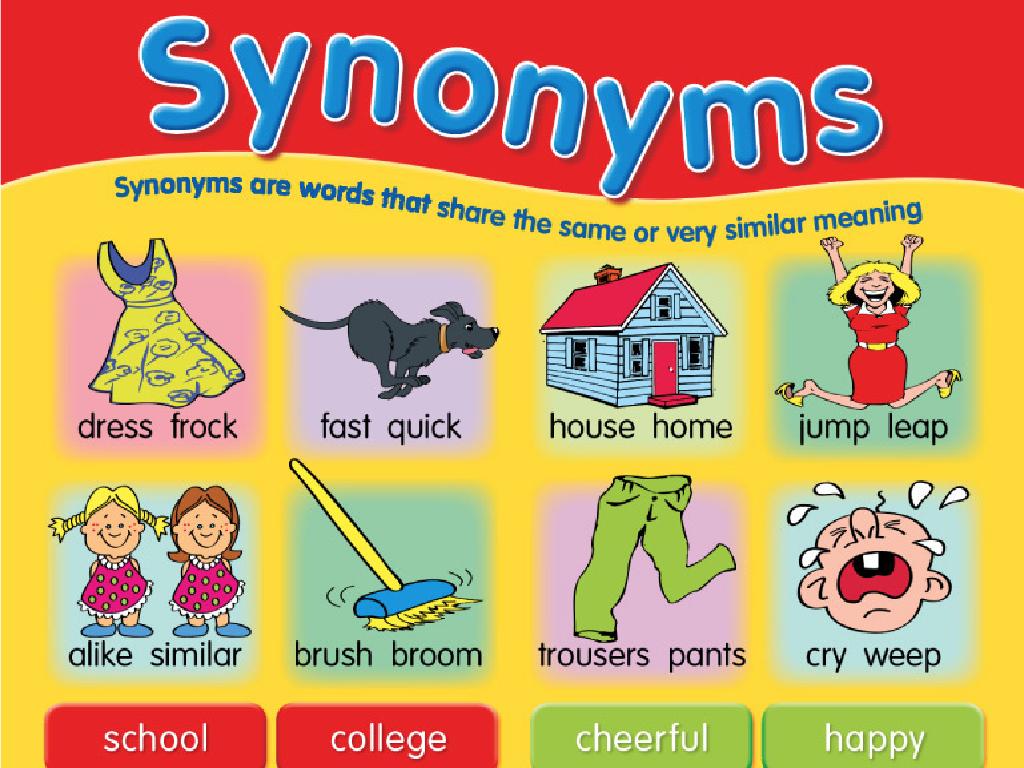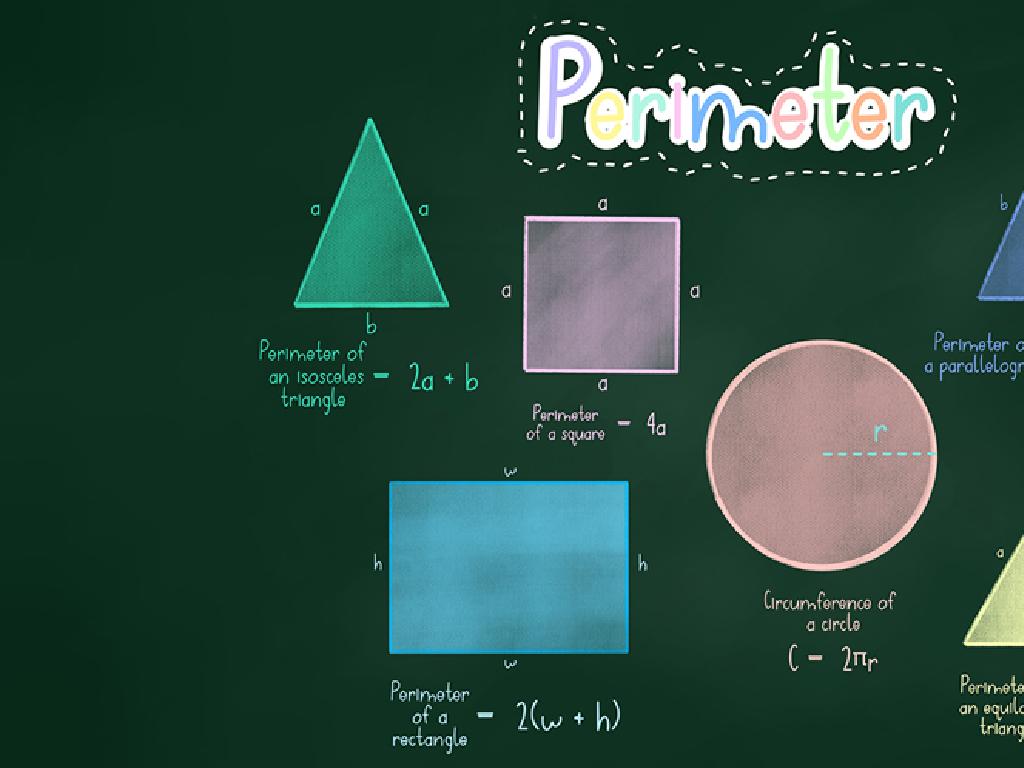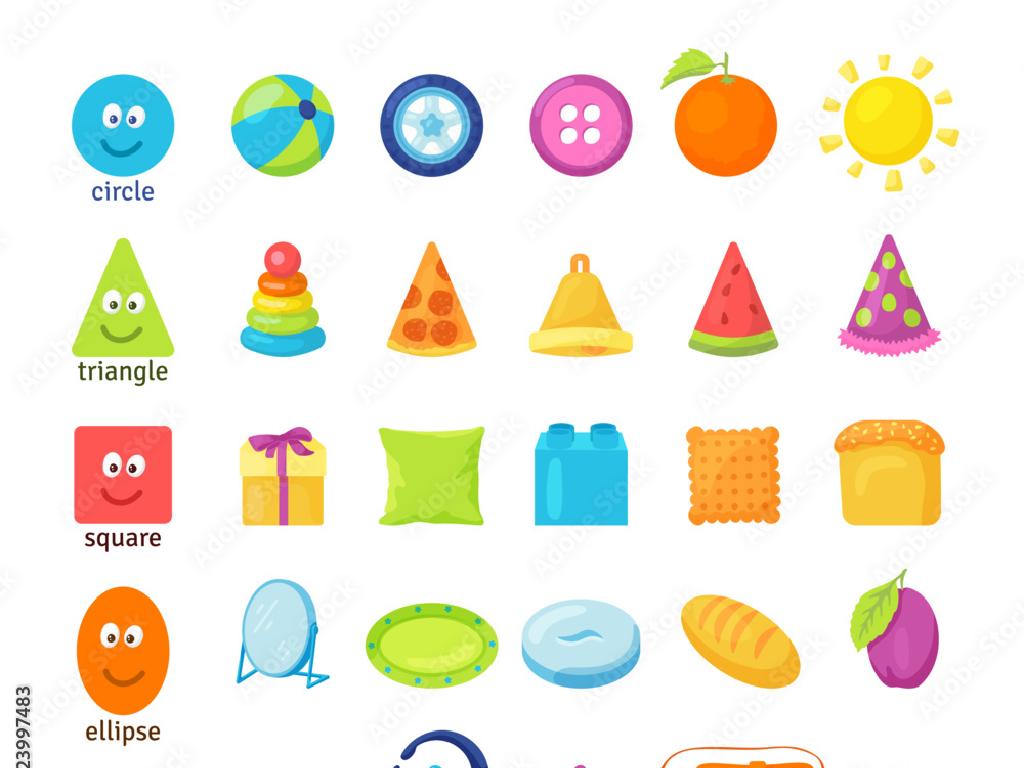Fractions Of A Group
Subject: Math
Grade: Third grade
Topic: Understand Fractions
Please LOG IN to download the presentation. Access is available to registered users only.
View More Content
Welcome to Fractions of a Group!
– Fractions represent parts of a group
– Like 2/4 of pizza means 2 out of 4 slices
– Each fraction has a numerator and denominator
– Top number (numerator) is how many parts we have
– Examples help us learn fractions
– Using items like pizza slices or colored blocks
– Practice with real objects
– Let’s use items in class to see fractions in action
|
This slide introduces the concept of fractions as parts of a group to third-grade students. Begin by explaining that a fraction represents a number of equal parts of a whole or a group. The numerator (top number) indicates how many parts we’re looking at, while the denominator (bottom number) shows how many equal parts the whole is divided into. Use relatable examples such as slices of pizza or a set of colored blocks to illustrate the concept. Encourage students to visualize and practice with real objects to reinforce their understanding. This hands-on approach helps to demystify fractions and shows their practical application in everyday life.
Understanding Fractions
– A fraction shows part of a whole
– Top number: the numerator
– The numerator is above the line in a fraction
– Numerator: number of parts you have
– If you have 2 out of 4 pieces, 2 is the numerator
– Bottom number: the denominator
– The denominator is below the line in a fraction
|
This slide introduces the concept of fractions to third-grade students. Begin by explaining that a fraction represents a part of a whole, like a slice of pizza out of a whole pizza. The top number, or numerator, indicates how many parts we are considering, while the bottom number, or denominator, shows into how many total parts the whole is divided. Use visual aids like pie charts or divided bars to help students visualize fractions. Encourage students to think of fractions in terms of everyday items, such as pieces of fruit or a group of friends. This foundational understanding will be crucial as they learn to perform operations with fractions.
Fractions of a Group
– Fractions show group parts
– Taking 1 out of 4 apples
– If you have 4 apples and take 1, you’re left with 1/4.
– 1 apple is 1/4 of all apples
– It means 1 out of the total 4 apples is what you have.
– Let’s explore examples!
– We’ll use pictures and objects to learn this.
|
This slide introduces the concept of fractions as they apply to groups of items, which helps students understand that fractions are not just for parts of a whole object, but also for parts of a set of objects. Start by explaining that when we talk about fractions of a group, we are looking at how many parts of the group we have compared to the total. Use the example of apples to make it relatable. Have various examples ready, such as slices of pizza, groups of pencils, or collections of stickers, to illustrate the concept. Encourage students to bring their own examples and use manipulatives to make the learning process interactive and engaging.
Understanding 1/2: Fractions of a Group
– What does 1/2 represent?
– 1/2 signifies half of a whole or group
– Example: 6 circles, 3 shaded
– Visualize 6 circles: if 3 are shaded, that’s half
– 1/2 means half are shaded
– Shaded circles show 1/2 of the total
– 1/2 applies to any group
– Whether it’s circles, apples, or stars, 1/2 is always half
|
This slide introduces the concept of fractions, specifically 1/2, to third-grade students. Begin by asking what 1/2 represents to ensure students understand it signifies half of a group. Use a visual example of 6 circles, with 3 shaded, to illustrate that 1/2 of the circles are shaded. Emphasize that 1/2 means half of any group, regardless of the total number. Encourage students to think of other examples where they can apply the concept of 1/2, such as splitting a sandwich or sharing toys. This will help them grasp the idea of fractions in everyday life.
Understanding Fractions: 1/4 of a Group
– Visualizing 1/4 with stars
– 2 out of 8 stars are shaded
– If we shade 2 out of 8 stars, we have shaded 1/4 of them.
– 1/4 represents one part of four
– Think of a pizza cut into 4 pieces; 1/4 is one slice!
– Recognizing fractions in groups
– Practice by grouping objects and finding 1/4.
|
This slide introduces the concept of fractions, specifically 1/4, to third-grade students using visual aids like stars. Start by showing 8 stars and shade 2 to illustrate how 1/4 of the stars are shaded. Explain that 1/4 means one out of four equal parts, using relatable examples like slices of pizza. Emphasize that when we look at a group of items, finding 1/4 means dividing the group into four equal parts and looking at one of those parts. Encourage students to practice this concept by dividing different sets of objects into quarters and identifying 1/4 of each set.
Let’s Practice Fractions Together!
– Observe the groups I show
– Tell me the fraction that’s shaded
– Remember the whole group count
– How many pieces are there in total?
– Focus on the shaded parts
– How many of those pieces are colored in?
|
This slide is designed for an interactive class activity to practice identifying fractions of a group. Display different groups with shaded and unshaded parts to the class. Ask the students to observe carefully and determine what fraction of the whole group is shaded. Remind them to count all the pieces to identify the denominator (the whole) and then count the shaded pieces to find the numerator (the part). This exercise will help reinforce their understanding of fractions as parts of a whole. Possible activities include using images of shaded shapes, groups of objects, or illustrations that represent parts of a group. Encourage participation and assist students who may have difficulty understanding the concept.
Your Turn: Create Fractions of a Group
– Draw a group of shapes
– Shade a part to show a fraction
– For example, shade 2 out of 4 circles to show 1/2
– What fraction did you shade?
– Share your fraction with the class
|
This activity is designed to help students apply their understanding of fractions to a group of objects. Provide students with paper and drawing materials. Instruct them to draw a group of identical shapes, such as circles or squares. Then, they should shade a certain number of these shapes to represent a fraction of the whole group. Encourage creativity in the number of shapes and the fraction represented. After completing their drawings, students will share with the class the fraction of the shapes they shaded and explain how they determined it. This will reinforce their understanding of fractions as part of a group and allow them to practice explaining their thought process. Prepare to offer guidance and ensure each student has a chance to participate.
Class Activity: Fraction Bingo
– Let’s play Fraction Bingo!
– Receive your unique bingo card
– Each card has different fractions
– Spot groups matching your fractions
– Look for objects or pictures in groups that fit the fraction on your card
– Mark five in a row to win!
|
This interactive activity is designed to help students recognize and understand fractions in a group setting. Distribute unique bingo cards to each student, ensuring that the fractions represented vary across the cards. Use objects or images to visually represent groups that correspond to the fractions on the bingo cards. As you display each group, students will identify whether the shown fraction matches any on their card and mark it accordingly. The goal is to reinforce the concept of fractions by finding real examples in a fun and engaging way. Prepare a small reward for the winner to motivate participation. Additionally, have a few variations of the game ready, such as four corners or full card bingo, to keep the activity dynamic and interesting.
Fantastic Fractions Finale
– Congratulations on learning fractions!
– Identifying and creating group fractions
– Remember, fractions show parts of a whole group
– Practice is key to mastering fractions
– Try exercises to get even better
– Keep practicing at home for perfection
|
This slide wraps up the lesson on fractions of a group. It’s meant to congratulate the students on their hard work and encourage them to continue practicing. Emphasize the importance of understanding fractions as part of a group, as it’s a fundamental math skill. Provide some suggestions for practice activities they can do at home, such as dividing groups of toys or snacks into fractions. Remind them that learning is a process, and the more they practice, the better they’ll get at identifying and creating fractions of a group.






